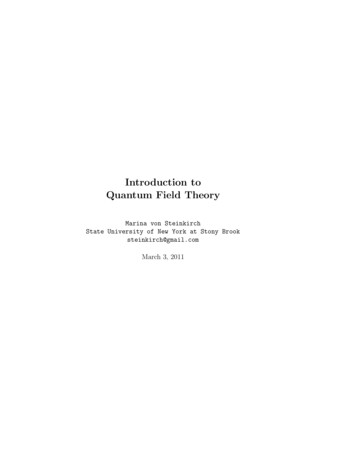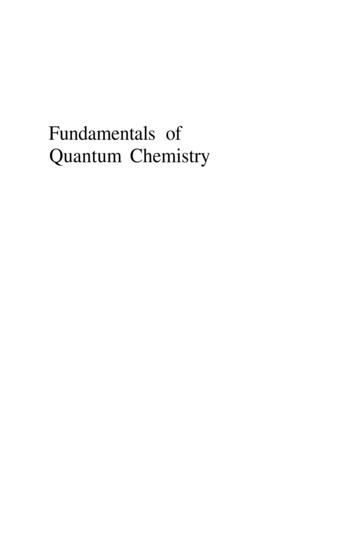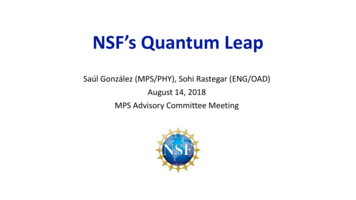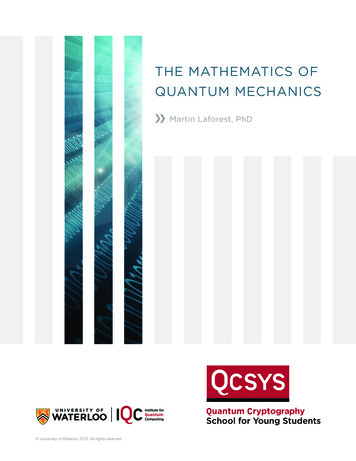
Transcription
Introduction toQuantum Field TheoryMarina von SteinkirchState University of New York at Stony Brooksteinkirch@gmail.comMarch 3, 2011
2
PrefaceThese are notes made by a graduate student for graduate and undergraduate students. The intention is purely educational. They are a review ofone the most beautiful fields on Physics and Mathematics, the QuantumField Theory, and its mathematical extension, Topological Field Theories.The status of review is necessary to make it clear that one who wants tolearn quantum field theory in a serious way should understand that she/heis not only required to read one book or review. Rather, it is importantto keep studies on many classical books and their different approaches, andrecent publications as well. Quantum field theories, together with topological field theories, are fields in evolution, with uncountable applications anduncountable approaches of learning it.The idea of these notes initially started during my first year at StonyBrook University, when I was very well exposed to the subject, duringthe courses taught by Dr. George Sterman, [STERMAN1993], and by Dr.Dmitri Kharzeev, [KHARZEEV2010] . However, most of the first part ofthese notes was studies from classical books, mainly [PS1995], [SREDNICKI2007],[STERMAN1993], [WEINBERG2005], [ZEE2003]. This is just a tasting ofa huge and intense field. In the continuation of the journey, I’m workingon some derivations on topological quantum field theories, from classicalrefereces and books such as [IVANCEVIC2008], [LM2005], [DK2007], andthe pioneering work of Edward Witten, [WITTEN1982], [WITTEN1988],[WITTEN1989], and [WITTEN1998-2].I have divided this book into two parts. The first part is the old-school(and necessary) way of learning quantum field theory, and I shall call thissection Fundamentals of Quantum Field Theory. In this part, in the firstthree chapters I write about scalar fields, fields with spin, and non-abelianfields. The following chapters are dedicated to quantum electrodynamics andquantum chromodynamics, followed by the renormalization theory.The second part is dedicated to Topological Field Theories. A topologicalquantum field theory (TQFT) is a metric independent quantum field theory3
4that introduces topological invariants of the background manifold. The bestknown example of a three-dimensional TQFT is the Chern-Simons-Wittentheory. In these notes I start with an introduction of the mathematicalformalism and the algebraic structure and axioms. The following chaptersare the introduction of path integral and non-abelian theories in the newformalism. The last chapters are reserved to the three-dimensional ChernSimons-Witten theory and the four-dimensional topological gauge theoryand invariants of four-manifolds (the Donaldson and Seiberg-Witten theories).I do not believe it is possible to ever finish this book, and probablythis is exactly the fun about it. One property of Science is that there isalways more to learn, more to think and more to discovery. That’s whatmakes it so delightful! I conclude this preface citing Dr. Mark Srednick on[SREDNICKI2007],You are about to embark on tour of one of humanity’s greatestintellectual endeavors, and certainty the one that has producedthe most precise and accurate description of the natural world aswe find it. I hope you enjoy your ride.AcknowledgmentThese notes were made during my work as a PhD student at State University of New York at Stony Brook, under the support of teaching assistant,and later of research assistent, for the department of Physics of this university. I’d like to thank Prof. Dima Kharzeev, Prof. George Sterman, Prof.Patrick Meade, Prof. Sasha Kirillov, Prof. Dima Averin, and Prof. BarbaraJacak, for excellent courses and discussions, allowing me to have the basicunderstanding to start this project.Marina von Steinkirch,January of 2011.
ContentsIFundamentals of Quantum Field Theory1 Spin Zero1.1 Quantization of the Point Particle . .1.2 Form Invariant Lagrangians . . . . . .1.3 Noether’s Theorem . . . . . . . . . . .1.4 The Poincare Group . . . . . . . . . .1.5 Quantization of Scalar Fields . . . . .1.6 Transforming States and Fields . . . .1.7 Momentum Expansion of Fields . . . .1.8 States and Fock Space . . . . . . . . .1.9 Scattering and the S-Matrix . . . . . .1.10 Path Integral and Feynman Diagrams2 Fields with Spin2.1 Dirac Equation and Algebra . . . . .2.2 Spinors . . . . . . . . . . . . . . . .2.3 Vectors . . . . . . . . . . . . . . . .2.4 Majorana Spinors . . . . . . . . . . .2.5 Weyl Equation and Dirac Equation .2.6 Lorentz Transformations . . . . . . .2.7 Symmetries of the Dirac Lagrangian2.8 Gauge Invariance . . . . . . . . . . .2.9 Canonical Quantization . . . . . . .2.10 Grassmanian Variables . . . . . . . .2.11 Discrete Symmetries . . . . . . . . .2.12 Chirality . . . . . . . . . . . . . . . .2.13 The Parity Operators . . . . . . . .2.14 Propagators in The Field . . . . . 515354
6CONTENTS3 Non-Abelian Field Theories593.1 Gauge Transformations . . . . . . . . . . . . . . . . . . . . . 603.2 Lie Algebras . . . . . . . . . . . . . . . . . . . . . . . . . . . . 613.3 Spontaneous Symmetry Breaking . . . . . . . . . . . . . . . . 644 Quantum Electrodynamics4.1 Functional Quantization of Spinors Fields4.2 Path Integral for QED . . . . . . . . . . .4.3 Feynman Rules for QED . . . . . . . . . .4.4 Reduction . . . . . . . . . . . . . . . . . .4.5 Compton Scattering . . . . . . . . . . . .4.6 The Bhabha Scattering . . . . . . . . . .4.7 Cross Section . . . . . . . . . . . . . . . .4.8 Dependence on the Spin . . . . . . . . . .4.9 Diracology and Evaluation of the Trace .697171727373737676785 Electroweak Theory815.1 The Standard Model . . . . . . . . . . . . . . . . . . . . . . . 816 Quantum Chromodynamics6.1 First Corrections given by QCD .6.2 The Gross-Neveu Model . . . . . .6.3 The Parton Model . . . . . . . . .6.4 The DGLAP Evolution Equations6.5 Jets . . . . . . . . . . . . . . . . .6.6 Flavor Tagging . . . . . . . . . . .6.7 Quark-Gluon Plasma . . . . . . . .7 Renormalization7.1 Gamma and Beta Functions . . . . . . . . . .7.2 Dimension Regularization . . . . . . . . . . .7.3 Terminology for Renormalization . . . . . . .7.4 Classification of Diagrams for Scalar Theories7.5 Renormalization for φ34 . . . . . . . . . . . . .7.6 Guideline for Renormalization . . . . . . . . .85. 85. 87. 87. 93. 98. 100. 100.103. 103. 104. 108. 109. 111. 1138 Sigma Model115II117Topological Field Theories
Part IFundamentals of QuantumField Theory7
Chapter 1Spin ZeroIn this first chapter we will begin studying scalar fields, i.e. particles with nospin. They are the simplest way of getting the first techniques of quantumfield theory, even though there is no known scalar particles in nature.1Before we start our journey in quantum field theory, I would like to saytwo important things. One of them is that it is always useful to performdimensional analysis on our Lagrangians, operators, etc. In the naturalunits, where[l] [t] [m] 1 [E] 1 ,we have [L] E 4 .When we are working on phenomenological problems, it is also useful toremember that 200 MeV 1 fm 1 .1.1Quantization of the Point ParticleSupposing a particle with only a defined momentum, with no charges and nospin, such as the Dirac’s original photon. The recipe of quantization from aclassical picture is:1. Start with a coordinate q(t), and the classical Lagrangian L(q(t), q̇(t)).2. Write the Hamiltonian Hcl (p, q) pq̇ Lcl , where p is the conjugatemomentum. 3. Postulate H(p̂, q̂)ψ i qψ.1There are theoretical candidates for scalar fields in nature, such as some models including the Higgs particle.9
10CHAPTER 1. SPIN ZERO4. For the nonrelativistic case, the Hamiltonianp of the free particle isp2H 2m , for the relativistic case it is H c p2 (mc)2 .In the same logic one can restrict the global field to a local field theoryon x, writing the Lagrangian asZ L(t) d3 xL φa (x, t), dµ φa (x, t) .The action is thenZt2Sv Zt2dtdtL(t) t1t1ZV(t0 )d3 xL[φa ].The Principle of Minimum Action says that any variation on the actionshould be zeroδS 0.δφ(x, t1 ) δφ(x, t2 ) 0,and from performing this variation on the action,!Z L L30 dtdxL( µ φa ) ,δφa φa ( µ φa )!Z L L dtdx3 δa , φi xµ ( µ φi )one gets the Lagrange’s equations of motion for this field, L φi L 0.µ x ( µ φi )(1.1.1)Example: The real Klein-Gordon EquationThe Klein-Gordon Lagrangian3 is21L [( µ φ)( µ φ) m2 φ2 ],2(1.1.2)and by varying the action, one can find its equation of motion(2 m2 )φ 0.2This is the density of the Lagrangian, but since it is a common practice to call it justLagrangian, we will follow this convention here.
1.2. FORM INVARIANT LAGRANGIANS11Example: Complex Scalar FieldTreating the field and its complex conjugate as independent,φ (φ1 iφ2 ),one can writes a Lagrangian asL µ φ µ φ m2 φ φ.1.2(1.1.3)Form Invariant LagrangiansA transformation on the Lagrangian is relevant for quantum field theorywhen this transformation keeps the Lagrangian form invariant,L̄(φ̄, φ̄i φi d4 x) L(φ(x),).i y µ x d4 yL̄d4 y L̄d4 x.(1.2.1)(1.2.2)For these cases of transformations, solutions in the equation of motionon x implies solutions in y. The most general invariant transformation isgiving by modifying equation (1.2.2) by any term that lives on the surface,µ4for instance dFdy µ d y.In the case of our local field, we can generalize the invariance studyingthe infinitesimal transformations of coordinates and fields. Introducing a setof parameters {βα }Nα 1 , in terms of a small δβα :x̄ xµ δxµ (δβα ) xµ φ̄i φi (x) δφi (δβα ) φi (x) NX (δxµ )δβα , (δβα )(1.2.3) (δφi )δβα . (δβα )(1.2.4)α 1NXα 1One exampleit is the translation transformation where δxµ δaµ and (δxµ )one has (δaµ ) gνµ δµν .1.3Noether’s TheoremEvery time we have a transformation on the Lagrangian that keeps it invariant, we can say that we have a symmetry. From the Noether’s Theorem,
12CHAPTER 1. SPIN ZEROL(φi , δµ φi ) forms N conserved currents and charges. Therefore, under sometransformation with N parameters one has the conserved current µ Jaµ 0,(1.3.1)Jaµ L (δxµ ) (βa ) Xφi L (δ φi ), ( µ φi ) (βa )(1.3.2)where a runs from 1 to N and βa is the parameters of variation defined lastsection. To apply (2.7.1), one needs to understand the concept of variationat a point, which is the variation between two fields at a point, i.e.δ φi φ̄i (x) φi (x).The current can also be rewritten in the form of the Energy-Moment Tensor,using a more compact notationδL α φ Tαµ . ( µ φ)Jaµ Lδαµ This tensor can be integrated on the space givingZZν30νP d xT d3 xTλ0 g λν .(1.3.3)(1.3.4)To extract the important informations of this equation one separates thetensor in the temporal (energy) and spatial (momentum) parts. The energyis given by the zeroth component of (1.3.4):Z0P d3 xT 00 .Defining the conjugate momentum asΠi δL 0 φ i , φ̇ithe other components are given byZXiP d3 x[Πi φ̇i L],iwhere the current vector isP ZXd3 x[Πi φi ].i
1.4. THE POINCARE GROUP13A second conserved quantity is the angular momentum given byZijL d3 x(xi P j xj P i ).A third quantity that is conserved is the charge,Z φQi d3 xΠi i . xA consequence of (1.2.4) is that any Lagrangian of a complex scalarfieldsPis form invariant under a phase transformation, i.e. φ̄(x) ei βa ta φ(x).These are the transformations generated by the gauge group U (1). If onestarts with a defining representation R of this Lie group, the conservedcurrent is)(NX LR µ[t ]ij φj complex conjugate ,Ja i ( µ φ i ) ai,j 1where tRa is the generators of this representation.Example: The U (1) transformation for the complex KleinGordon EquationFrom (1.1.3), one can add a potential field of the kind U ( φ 2 ),L ( µ φ)( µ φ ) m2 φ 2 U ( φ 2 ),Writing φ̄(x) eiθ φ(x), the parameter θ is conserved, giving one conserved current. This charge is exactly the electromagnetic charge when itcouples to the field.1.4The Poincare GroupThe Poincare group is the group of translations (aµ ) plus the Lorentz transformations (Λµν ),x̄µ Λµν xν aµ ,which representation is given by D(a, Λ). The Lorentz transformations aredefined byx̄µ Λµν xν ,Λµν gµα g νβ Λαβ ,Λµν (Λ 1 )µν .
14CHAPTER 1. SPIN ZEROThe six generators (δλ) are found near the identityΛµν δνµ δλµν , (I δλ)µν ,(1.4.1)(1.4.2)where in general the determinant of Λ is 1. This matrix can be writtenexplicitly for a representation with a rotating term and then a boost asΛµν (eiω.k e iθ.j )µν .The generators of the Poincare group in the representation of the fieldsφb are(p̂µ )ab iδab µ .(m̂µν )ab iδab (xµ ν xν µ ) (Σµν )ab ,with an algebra given by[p̂µ , p̂ν ] 0,[p̂µ , m̂λγ ] igµλ p̂σ igµσ p̂λ ,[m̂µν , m̂λν ] igµλ m̂νσ 3 terms.1.5Quantization of Scalar FieldsTo start the quantization of the fields φ and its conjugate momentum Π,one postulates the basic equal-time commutators (ETCRS),1.6[φ(x, x0 ), Π(y, x0 )] i δ 3 (x y),(1.5.1)[φ (x, x0 ), Π (y, x0 )] i δ 3 (x y),(1.5.2)[φ(x, x0 ), φ(y, x0 )] [Π(x, x0 ), Π(y, x0 )] 0.(1.5.3)Transforming States and FieldsTo see how one transforms states and fields, let us suppose the system inthe frame F , with states ψi. In the frame F̄ , with states ψ̄i, one needs tofind a unitary transformation U 1 U T such as ψ̄i U (F, F 0 ) ψi,(1.6.1)
1.6. TRANSFORMING STATES AND FIELDS15which must preserve the norm hψ ψi 1. The classical transformation ofour fields is given byφ̄b (x̄) δba (Λ)φa (x),which in quantum mechanics meanshψ̄ φ̄b (x̄) ψ̄i δba (F̄ , F )hψ φk (x) ψi.Therefore, one rewrites ((1.6.1)) as ψi U 1 (F, F 0 ) ψ̄i,hψ hψ̄ U (F, F 0 ),gettingDE DEψ̄ {φ̄b (x̄) δab (Λ)φa (x)} ψ̄ ψ U 1 δab (Λ)φa (x)U ψ .Example: Translation as a Unitary TransformationIn a transformation such as translation, the unitary matrix is given byµ (x)U (a) eiaµ pU (a)φ(x)U 1,(1.6.2)(a) φ(x a).(1.6.3)To see how (1.6.3) works, one can insert it as unity (U 1 U 1), and seehow translation invariance appears connecting the fields:hp2 nYφ(xi ) p1 i e i(p1 p2 )a hq2 i 1Yφ(xi a) q1 i.iThe unitary translation operator, which we shall call F, can then beseen as a spatial shift on the states x0 i x0 dx̄ i,F(x0 ) x0 dx̄ i,F(x0 ) 1 ik.dx,i1 p.dz, respecting the canonical commutations that we know from quantum mechanics,[xi , kj ] iδij or [xi , pj ] i δij .
16CHAPTER 1. SPIN ZERO1.7Momentum Expansion of FieldsWe have now our fields quantized and we can work on the momentum expansion of the fields. This involves their Fourier transformationsZφ̃(k, x0 ) d3 xe ikx φ(x, x0 ),ZΠ̃(k, x0 ) d3 xe ikx Π(x, x0 ).It is necessary to write our φ and Π in terms of the creation/annihilationoperators (such as when we do it for x and p in quantum mechanics, definingthe raising/lowering operators), as can be seen in (1.7.1),!1a(k, x0 ) ωk φ̃(k, x0 ) iΠ̃(k, x0 )(2π)3/2!(1.7.1)1†ωk φ̃(k, x0 ) iΠ̃(k, x0 )a (k, x0 ) (2π)3/2 where ωk k 2 m2 , which is the on-shell energy equation4 E 2 p2 m2 . The four-vector notation can be written as k µ (ω, k).From the definition of the ETCR given by (1.5.1), (1.5.2) and (1.5.3),one can then computes the ETCRs for (1.7.1), 3[a(k, x0 ), a† (k, x0 )] 2 ωk δ 3 (k k 0 ),(1.7.2)[a, a] [a† , a† ] 0.(1.7.3)Using ((1.7.1)) to rewrite the fields in terms of the creation/annihilationoperators, we haveZd3 kφ(x, x0 ) [a(k, x0 )eikx a† (k, x0 )e ikx ],3/2 2ω(2π)kZ(1.7.4)d3 kikx† ikxΠ(x, x0 ) i[a(k,x)e a(k,x)e].00(2π)3/2 2Substituting (1.7.4) in the Hamiltonian for scalar fields, one getsZ1d3 k[a(k, x0 )a† (k, x0 ) a† (k, x0 )a(k, x0 )].(1.7.5)H 43Setting c 1, the natural unit.
1.8. STATES AND FOCK SPACE17A remarkable characteristic of the free fields is the fact that the Lagrangian is quadratic in fields, as you can see in (1.7.5). Making use of thetemporal evolution of the fields, one can calculate the commutation of thecreation/annihilation operator with this Hamiltonian,[H, a(k, k0 )] 1.8da(k, x0 ) ωk a(k, x0 ).dtStates and Fock SpaceThe Fock Space is defined by the kets {k1 }i, where all states are found byapplying the raising/creation operators from the ground states. Considering E 0 i a† (k) Ei,one computesH E 0 i Ha† (k) Ei, [H, a† (k)] Ei a† (k)H Ei, ωk a† (k) Ei Ea† (k) Ei, (E ωk ) E 0 i,which clearly shows the shift on the energy when one applies the Hamiltonianoperator on some eigenstate. Requiring that the system has a ground state 0i allowsa(k) 0i 0,Therefore, it is possible to define the following states as k1 , ., kn i nYa† (ki ) 0i,i 1and applying the Hamiltonian operator, one finally hasXH k1 , ., kn i ω(ki ) k1 , ., kn i.i 1The dimension of the space is given by F F0 F1 . FN , whereN in F is determined by the number operator,Z 3d k †N a (k)a(k),(1.8.1)2ωkNN Y Y Na† (ki ) 0i na† (ki ) 0i .(1.8.2)i 1i 1
18CHAPTER 1. SPIN ZEROIt is necessary to normal order N , i.e. relocate all a’s right to a† ’s. Fromthis, one can rewrites the Hamiltonian (1.7.5) as14Zd3 k [a(k), a† (k)] 0i,Zωk 33 δ (0) d3 kδ (0),2H 0i where the delta function is defined asZd3 x ix(k k0 )e.δ 3 (k k 0 ) (2π)3The normal ordered Hamiltonian is then given byZ1: H : d2 k a† (k)a(k).2: H : ai 0.(1.8.3)(1.8.4)(1.8.5)From these results, an important completeness relation is given byZ1 0ih0 1.91d3 k kihk 2ωk2Zd3 k1 d3 k2 k1 k2 ihk1 k2 .2ωk2 ωk1(1.8.6)Scattering and the S-MatrixThe theory we have been developed should be used to calculated the simplestprocess on field theories, a particle scattering. In such process there will aninitial state, IN, which we say that is very far before the scattering moment,and a final state, OUT, taken a long time after the scattering moment. Onceone assumes completeness of these both states and waiting long enough, anystate will constitute a superposition of separable particles. Quantitativelyone may say that All particles were separated:Pσ αin ihαin 1. All particles are eventually separated:Pσ βout ihβout 1.
1.9. SCATTERING AND THE S-MATRIX19The S-matrix is the amplitude for a system that was simple in the pastand which will be simple in the future, and is defined bySαβ hβout αin i,with the following proprieties,1. Completeness: S is unitary.2. T-matrix: another unitary matrix can be obtained by S 1 iT .3. Probabilistic interpretation: the process β α has the probability Sαβ 2 , and α β, Sβα 2 .Causal Green’s FunctionThe Green’s functions are connective solutions for equations of the type(2x m2 )G(x x0 ) δ 4 (x x0 ),which the solutions with sources are(2x m2 )φ J.In the scalar field Lagrangian such as (1.1.3), one can insert an additionalquadratic term which represents the fields acting on itselfL φ 2 m2 φ2 λ( φ2 )2 .For such a problem, the solution of the equation of motion can be givenby the causal Green’s function(k 2 m2 )G̃(k) 1,Z0G̃(k̃) d4 xe i(k k ) G(x x0 ),G̃(k) k21. m2The Green’s function has an important role on field theory, this connection propriety ultimately will be used to represent transition amplitudebetween states,G(x1 , ., xN ) h0 T φ(x).φ(xn ) 0i.(1.9.1)
20CHAPTER 1. SPIN ZEROThe Reduction TheoremThe reduction theorem relates the Green’s function for states, (1.9.1) to theS-MatrixS(qj , ki ) h{qj }out {ki }in i,S(qj , ki ) nY132i(2π) R n m(qj2 m2j )j 1mY(ki2 m2i )G̃(qi ki ),ki2 m2i ,qi2 m2ii 1where R (2π)3 h0 φ(0) ρi 2 . In each isolated particle, G̃ has a separatedpole and the residue is S. The construction is possible by considering a largetime where the wave are isolated particles.1.10Path Integral and Feynman DiagramsTo start the study of Path Integral, we need to define the concept of stationary phase, which is the previous transition amplitude as the product of allpossible trajectories for two classical coordinates q 0 and q 00 ,U (q 00 , t00 , q 0 , t0 ) hq 00 , t00 q 0 , t0 i, limn m2πiδt !n2n ZY1dqi e Pjδt L(qk ,q̇j ).i 1The stationary phase integral for the path integral, in the semi-integralapproximation, is given by the classical variations. We can, define the generating function of q(t) asZ q2R t001Z[J] [dq]e [S t0 dtJ(t)q(t)](1.10.1)q1RThe transition for fields is made by the formal substitution [dp][dq] [dπ][dφ], which can have the interpretation of transforming one harmonicoscillator to infinite number of harmonic oscillators, all labeled by their wavenumber k. The generating are thenZR 4 1R 4iWδa [J(xµ )] [dφ]e d x 2 [SL0 d xJ(x)φ(x)] ,ZR 4 1 µ 2i2 2 [dφ]e d x 2 [( φ) m φ J(x)φ(x)] ,R
1.10. PATH INTEGRAL AND FEYNMAN DIAGRAMS21where the last term can be seen as a charge source.Let us recall the procedure of Wick’s rotation , which is the method offinding a solution to a problem in Minkowski space from a solution to arelated problem in Euclidean space. The Wick’s rotation consists in performing the transformation t iτ , making it on W [J] for the single degreeof freedom. From t[y] e iθτ , 0 θ π2 , it is possible to write W [J] lim θ 0 W [J, θ]. From ((1.10.2)), it is possible to construct the free fieldGreen’s functions from the transition amplitude,h0 T (φ(x)φ(y) 0i i f (x y),where the original equation of motion can be written as the(2x m2 ) f (x y) δ 4 (x y),where Euclidean delta function isZe ikxd4 k.i f (x) (2π)4 k 2 m2 i The Green’s function, from i terms of the generating functional, equation(1.10.2), is thenGN (x1 , ., xn ) nD Y E0Tφ(xi ) 0 , (i )nnYi 1δWδ [J],δJ(xi ) 0(1.10.2)(1.10.3)whereiWδ0 [J] e 2 Rd4 zd4 yJ(z) p (z y)J(y).(1.10.4)Equation (1.10.4) gives the Feynman Rules for scalars fields, summarizedas1. Write all possible distinguished graphics for the process.R d4 k12. For each line, associate the propagator (2π)4 k 2 m2 i .PP3. For each vertex associate ig(2π)4 g 4 δ( i Pi j kj ), where the deltafunction is over the sum of the momenta that come to the vertex.
22CHAPTER 1. SPIN ZERO
Chapter 2Fields with SpinA more realistic kind of field theories are those that obey the spin-statistictheorem, where all particles have either integer spin, bosons, or half-integerspin, fermions, in units of the Planck constant .2.1Dirac Equation and AlgebraPauli MatricesThe Pauli matrices are a set of 2 2 complex Hermitian and unitary matricesgiven by σ1 0 11 0 , σ2 0 ii 0 , σ3 1 00 1 .Together with the matrix identity, I, the Pauli matrices form an orthogonal basis. The sub-algebra of these matrices generate the real Cliffordalgebra of signature (3,0), and its proprieties are α12 α22 α32 I αi2 , det (σi ) -1, Tr (σi ) 0, [σi , σj ] 2i ijk σk , {σi , σj } 2δij I23
24CHAPTER 2. FIELDS WITH SPINDirac EquationWe now try to include the relativistic theory, represented byE 2 P 2 m2 ,(2.1.1)In the Schroedinger Equation, we want to construct an equation that, unlikeKlein-Gordon , is linear in t and is covariant (linear in ), with the generalformHψ ( α.P βm)ψ,(2.1.2)Pwhere α i αi , with i 1, 2, 3. Squaring 2.1.2 and comparing to 2.1.1givesH 2 ψ (P 2 m2 )ψ,(2.1.3)with the following conditions: αi , β all anti-commute with each other: {αi , β} 0. αi2 1 β 2 , so the anti-commutators are: {αi , αi } αi2 αi2 2 {β, β}.Clearly, ordinary numbers do not hold these proprieties, therefore we introduce 4 4 matrices operators (which are hermitian and traceless matricesof even dimensions, proprieties borrowed from the very first construction ofthe Pauli matrices, now extended in higher dimension), and consider thewave functions as column vector. The choice of the of these matrices arenot unique. We will choose the Dirac-Pauli representation, I 00 σi.,β αi 0 I σi 0The Weyl or chiral representation is given by the sets σi 00 IWWαi ,β .0 σiI 0Now back in 2.1.2. rewriting the operators H and P as i t and i xi , respectively (observe the metric ( )), and multiplying β on theleft of this equation,iβ t ( iβα m)ψ,(2.1.4)gives the covariant form of the Dirac equation 1 ,(iγ µ µ m)ψ 0,1(2.1.5)Note that we were not worried about the covariant/contravariant form of our tensorsbecause they were the same before. For now on we will work in the covariant form in themetric ( ).
2.1. DIRAC EQUATION AND ALGEBRA25with the inclusion of the four Dirac matrices γ µ (β, βαi ).Clifford AlgebraFrom the constrains that we have found for β and αi , we are going to derivethe algebra of the Dirac matrices, the Clifford algebra. First, let us resumethem in{αi , αj } 2δ ij and {β, β} 2 and {αi , β} 0.It is clear that introducing a four-vector notation will summarize them.Let us from this derive the algebra of a four-vector representation γ µ (β, βαi ), testing all possibilities of commutations. For i 6 j,{β, βαj } ββαi βαi β β 2 αi αi β 2 0.ij{βα , βα } βαi βαj βαj βαi αi β 2 αj αj β 2 αi {αi , αj }, 0.{β, β} β 2 β 2 , 2.Now, for i j,{βαi , βαi } βαi βαi βαi βαi , 2βαi βαi , 2αi ββαi , 2.Rewriting all in terms of γ-matrices,β γ0,βα1 γ 1 ,βα2 γ 2 ,βα3 γ 2 ,we can see clearly that{γ 0 , γ 0 } 2,{γ 0 , γ i } 0,{γ i , γ j } 2δ ij ,
26CHAPTER 2. FIELDS WITH SPINResulting, finally, in the Clifford Algebra,{γ µ , γ ν } γ µ γ ν γ ν γ µ 2g µν ,(2.1.6)where g µν is the element of the metric with the signature ( , , , ).We can prove 2.1.6 explicitly by actually substituting the Pauli matricesinto γ µ (β, βαi ). For example, for {γ 0 , γ 2 }, I 00 I 0σ2 σ 2 0 1 0 00 00 00 01 00 0 1 0 0 i0 0 100i0 0 ii 0 0,0 0 0 0and for {γ 3 , γ 3 }, 0σ33 σ02.2 0 σ 30 3 0σ 1000001 01 0 0 1 00 0 100 00001 1 00 1 2.0 0 0 0SpinorsRecalling equation (1.4.1), one can write the general space-time transformations of fields asφ̄a (x) Sab (Λ)φb (Λ 1 x a),which, near to the identity, can be writen as1Sab (1 δλ) δab iδλµν (Σµν )ab .2The matrices S(Λ) must obey the Poincar group proprieties S(Λ1 )S(Λ2 ) S(Λ1 , Λ2 ). The fields φb are tensors that transform according to the representation on S(Λ). In quantum field theory the transformations are unitary,therefore the representation of the Poincare groups is given by the matricesΛµν eiω.K e θ.J S(Λ),(2.2.1)resulting on the Lorentz transformations of the fields,U (a, Λ)φa (x)U 1 (a, Λ) Sab (Λ 1 )φb (Λx a).(2.2.2)
2.2. SPINORS27With the transformation matrices established, it is possible to constructthe algebra for the Poincare group on field theory. The Poincare algebra,(1.4.3), gives the Lie algebra for the generators K and J on (2.2.1),[Ja , Jb ] i abc Jc ,[Ka , Kb ] i abc Jc ,[Ja , Kb ] i abc Kc .(2.2.3)Setting the normalization T (j) 12 such that tr {ta , tb } T (j)δab , withj labeling an irreducible representation(irrep) of SU (2), one can write theCasimir operators in terms of the generators,3X2j[t(j)a ] j(j 1)I ,a 1Let us consider the Pauli matrices, defined as 0 11 0,, σx σ1 σ0 1 1 00 1 σy σ20 ii 0 , σ3 σz 1 00 1 .A representation for the Lorentz group for 2 2 system in the gaugegroup Sl(2, C), can be writen, and it is called spinors,1Ka iσa ,21Ja σa ,21K̃a iσa ,21 Ja σa .2(2.2.4)Substituting (2.2.4) back on (2.2.1), one hasσσh(Λ)ab (eω. 2 e iθ. 2 )ab ,h (Λ)ȧḃ (eω.σ 2e iθ.σ 2)ȧḃ ,(2.2.5)where ȧ, a runs from 1, 2, and in this representation, h 1 (Λ) h(Λ 1 ).Therefore, the spinor representation is double valued. For instance, for
28CHAPTER 2. FIELDS WITH SPINrotation only one has h (R) σ2 h(R)σ2 , which is not necessary truewhen adding a boost.The relation between h(Λ) to Λµν from (2.2.1) and (2.2.5) is conventionally given by taking the traceΛµν 1Tr [σ µ h(Λ)σν h† (Λ)],2(2.2.6)where σµ (σ0 , σ ). A rotational spinor η a (η 1 , η 2 ) is defined as a complexobject that transform on the following wayη̄ b h(Λ)ba η a ,ξ ḃ h (Λ)ḃȧ ξ ȧ .(2.2.7)(2.2.8)They are the Weyl spinors and they give scalars by constructingηa ab η b ,ξȧ ȧḃ ξ ḃ ,where ab ȧḃ 0 1 1 0 ,and ab ȧb ab .These matrices are characteristic in the symplectic Lie groups and transform with the Pauli matrices as σi 1 σiT . From this, one hasη̄a [h 1 (Λ)]ca ηc ηc [h(Λ)]ca ,ξ ȧ [h 1 (Λ)T ]ċȧ ξċ ξċ [h (Λ)]ċȧ .Applying this last resulting in the previous calculation to find the scalarsof the theory, one finds η̄a η̄ a ηa η a , (ξ ȧ ) ηa , and (ηa ) ηȧ .
2.3. VECTORS2.329VectorsFor a new field entity called vector, V µ , the transformations can be definedas(V )aḃ (V µ σµ )aḃ (V0 σ0 V. σ )aḃ ,where (V̄ )aḃ (ΛV )aḃ . They transform as a tensor, on the same fashion asspinors, (V̄ )aḃ h(Λ)ac h (Λ)ḃd (V )cd [h(Λ)V h† (Λ)]aḃ . (V̄ )aḃ ac ḃd (V )cd V 0 (σ0 )aḃ V (σ T )aḃ .Partial derivatives are vectors on field theory, and they are defined obeying the following transformations proprieties µ ( 0 , ), , xµ( )aḃ ( 0 σ0 σ )aḃ ,( )aḃ ( 0 σ0 σ T )aḃ .Let us remember what we know from the the electromagnetic theory.One can define the fields Aµ (x), which are massless like the photon (andbriefly become massive). The field strength is again defined asF µν µ Aν ν Aµ ,where11 Fµν F µν F 2 ,(2.3.1)44is the Maxwell
section Fundamentals of Quantum Field Theory. In this part, in the rst three chapters I write about scalar elds, elds with spin, and non-abelian elds. The following chapters are dedicated to quantum electrodynamics and quantum chromodynamics, followed by the renormalization theory. Th










